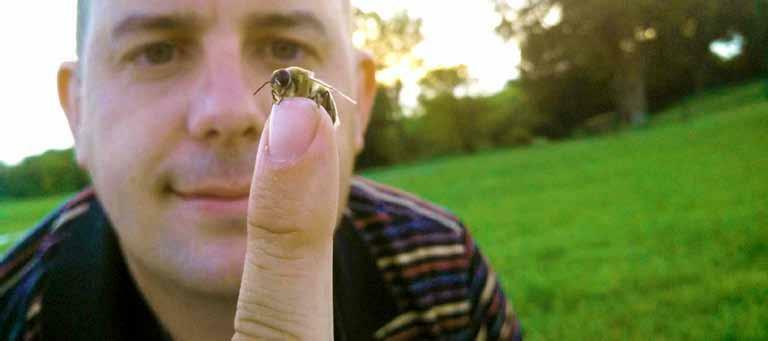
5 minute read
Sam keiSchnick Urban biologist works with people and animals in dream job
Urban biologist works with people and animals in dream job
B Y Ph IL rIDDL e
when Sam Keischnick expounds upon his career, one word pops up continually.
Lucky.
The Tarleton graduate earned his bachelor’s degree in biology in 2005 and finished his master’s studies three years later, delving into the genetics of pocket gophers.
He feels fortunate to have his job as an urban biologist for the Texas Parks and Wildlife Department, where he uses his education daily.
“I’m extremely lucky that I have this position,” Keischnick, a 2000 graduate of Aledo High School, said, explaining that he deals with the interaction of wildlife and people in the Fort Worth Metroplex. “It’s sort of unique.
“Normally when you think of wildlife biologists, you think of them in Big Bend or in the Big Country, studying some wild and elusive animal,” he muses. “Wildlife is in the city. It’s in Stephenville; it’s in Fort Worth, in Dallas.”
After studying for two years at Weatherford College, Keischnick had to choose where to continue his education.
“As soon as I got to meet the Tarleton biology professors, I was hooked,” he said. “That’s why I chose Tarleton. Now, since I’ve graduated, they’ve become my good friends, too. I get to talk with and collaborate with them.”
Since his graduation from Tarleton, Keischnick has been involved with several high-profile entities including the Fort Worth Nature Center and Refuge, the Fort Worth Museum of Science and History and the Botanical Research Institute of Texas. Additionally, he has taught in Tarleton’s biology department.
As part of his current duties with the TPWD, Keischnick leads a local Citizen Science group, a program sponsored by the National Wildlife Federation, for volunteers who help gather data for professional research.
“We go out and survey pieces of land, what we call a bioblitz,” he explained. “We survey as many different bugs and birds and plants, molds, fungi and mammals as we possibly can.”
The volunteers then photograph their finds and add them to a national database.
With the zeal of an evangelist, Keischnick cites the source of his good fortune.
“It’s a ‘pinch me’ job,” he said. “I’m very lucky I get to do this. I base a lot of my luck and my good fortune on my education at Tarleton,” he said.
Lucky guy.
Sam Keischnick
The Gift that Keeps on Giving
Anytime is a great time to give to Tarleton State University.
While the university receives state funding, it is not the sole source of finances to provide a high-quality, affordable educational experience. Tarleton relies on private support to fully develop its academic and athletic programs, recruit students and faculty, provide scholarships, and construct and update campus facilities.
Those private donations keep on giving and, to make sure they do, school leaders created the Tarleton State University Foundation, Inc. almost 40 years ago.
A nonprofit organization, the foundation provides financial assistance to Tarleton from earnings on endowed funds, gifts and property. It acts independently of the university and The Texas A&M University System solely for the benefit of the school.
“Private gifts help Tarleton continue its dynamic growth, development and excellence, and advance its vision to be the premier student-focused university in Texas and beyond,” said Foundation President J.D. “Chip” Davis. “Private gifts empower higher education, and education empowers people to transform lives and communities.”
Cash donations are welcome, as well as gifts of marketable securities, charitable annuities, real estate and personal property—like rare books, works of art and valuable collections. Contributions are tax deductible, as determined by the IRS. Donors should speak with an attorney or advisor about specific tax benefits or issues.
Donors can specify how they want their gift used, or allow Tarleton officials to choose based on university priorities and needs.
“Donors not sure where to begin might consider scholarships, faculty development and endowed professorships—Tarleton’s top priorities,” Davis explained. “An endowed scholarship—one awarded annually—is an investment in human capital and pays huge dividends. The university proves it every day with graduates who excel in their careers to improve quality of life.
“Yet, more than 80 percent of Tarleton students face challenges in funding their education and require some sort of financial aid,” he pointed out. “There’s no better way to leave a personal legacy or honor a loved one, friend or favorite professor or coach than by investing in young men and women destined to become great leaders.”
Gifts for faculty enhancement and professional development or to endow a faculty professorship help Tarleton attract top-notch scholars who add knowledge to their discipline and share that learning with their students.
Currently, Tarleton has two endowed faculty positions, but more are needed for the university to meet critical needs in Texas health care, business and engineering. The state is calling for universities to prepare more professionals in business and engineering, and private support is crucial.
The foundation, is managed by a 12-member volunteer board that meets twice a year. An audit of the foundation’s complete financial statements is conducted annually by an independent firm of certified public accountants.

For more information on the foundation, visit www.tarleton.edu/foundation.
To learn more about Tarleton’s Office of Development, go to www.tarleton.edu/giving.
Box T-0570 Stephenville, TX 76402 (254) 968-9000 | www.tarleton.edu

CENTENNIAL CELEBRATION
Corps of Cadet Commandant Col. Kenny Weldon, the Wainwright Rifles, along with Tarleton State University President Dr. F. Dominic Dottavio, and The Texas A&M University System Chancellor John Sharp were on campus in January 2017 to raise a Centennial flag in front of the E.J. Howell Education Building, which was the original Administration Building in 1917, the year that Tarleton joined the A&M System. Learn more about the yearlong Centennial Celebration: www.tarleton.edu/centennial









